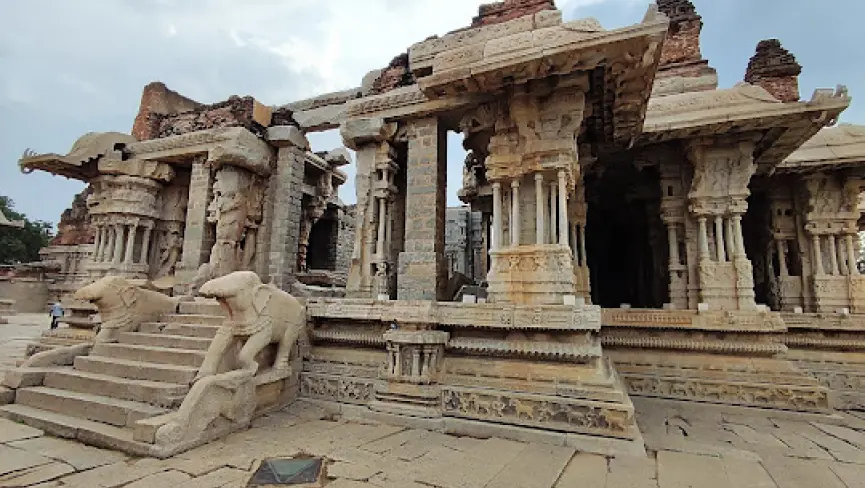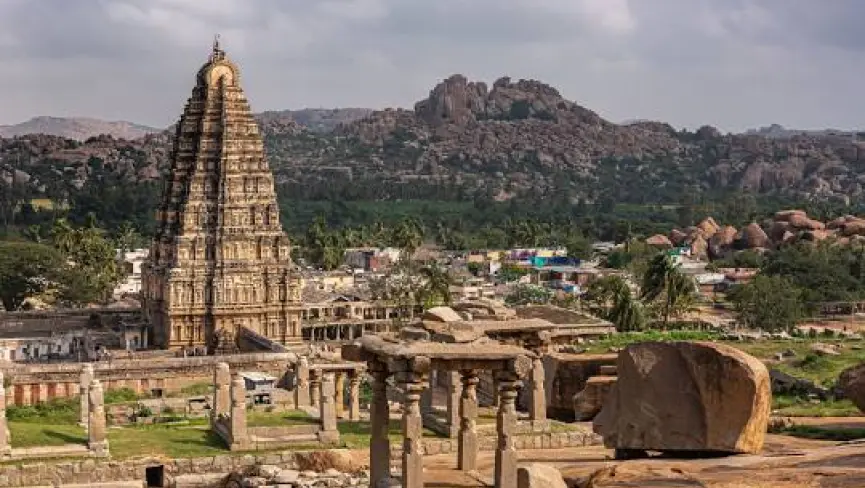
Hampi Uncovered: Everything You Need to Know Before Visiting
Hampi, the ancient capital of the Vijayanagara Empire, is a living museum of majestic ruins, giant boulders, sacred temples, and surreal landscapes. Located in Karnataka, India, this UNESCO World Heritage Site blends history, mythology, and raw natural beauty — making it a must-visit for history buffs, backpackers, and cultural explorers alike.
If you're planning your first visit to Hampi, this comprehensive guide covers what to see, how to get there, where to stay, and travel tips to make your journey unforgettable.
Where is Hampi?
Hampi is situated on the banks of the Tungabhadra River in northern Karnataka. Once one of the richest cities in the world during the 14th century, it now stands as a treasure trove of temple architecture, carvings, and ruined marketplaces spread across 4,000+ hectares.
Best Time to Visit Hampi
-
October to February: Ideal weather (cooler and dry); perfect for sightseeing.
-
March to May: Gets hot (35–40°C); fewer tourists but less comfortable.
-
June to September: Monsoon brings lush greenery but some paths may be slippery.
Pro Tip: Visit during the Hampi Utsav (usually in November) for cultural performances, parades, and temple rituals.
Top Things to See & Do in Hampi
1. Virupaksha Temple
Virupaksha Temple, located in Hampi, Karnataka, is one of the oldest and most revered temples in India, dating back to the 7th century. Situated on the banks of the Tungabhadra River, this magnificent temple is dedicated to Lord Shiva, known here as Virupaksha, the patron deity of the Vijayanagara Empire. A UNESCO World Heritage Site, the temple stands as a stunning example of Dravidian architecture, with its towering gopuram (gateway tower), intricate carvings, and pillared halls. The temple has been in continuous worship for over a thousand years, surviving the fall of the Vijayanagara Empire in the 16th century. It remains a major pilgrimage site and tourist attraction, drawing visitors for its spiritual significance, architectural grandeur, and the vibrant Hampi Utsav festival held annually. Virupaksha Temple is a must-visit destination for history enthusiasts, devotees, and travelers exploring South India's rich heritage.
2. Vijaya Vittala Temple & Stone Chariot
The Vijaya Vittala Temple, located in Hampi, Karnataka, is one of the most iconic and architecturally impressive monuments in India. Built in the 15th century during the reign of King Devaraya II of the Vijayanagara Empire, this temple is dedicated to Lord Vittala, an incarnation of Lord Vishnu. Renowned for its intricate Dravidian architecture, the temple complex features the world-famous Stone Chariot, a monolithic structure that resembles a real chariot and stands as a symbol of Hampi's rich cultural heritage. The temple is also famous for its musical pillars that produce melodic sounds when tapped. Nestled along the Tungabhadra River, the Vijaya Vittala Temple is a UNESCO World Heritage Site and a must-visit destination for history buffs, architecture enthusiasts, and spiritual travelers exploring Hampi, one of South India's most treasured historical sites.
3. Hemakuta Hill
Hemakuta Hill is a prominent heritage site located in Hampi, Karnataka, just south of the iconic Virupaksha Temple. This rocky hill is dotted with ancient temples, shrines, and pavilions, many of which date back to the 7th to 14th centuries, making it one of the most historically rich areas in Hampi. According to legends, this is the spot where Lord Shiva performed penance before marrying Goddess Pampa, and golden showers (hemas) were said to have fallen from the heavens — giving the hill its name, Hemakuta, meaning "Hill of Gold". The hill offers panoramic views of Hampi's ruins and the Tungabhadra River, especially stunning at sunrise and sunset. Hemakuta Hill is less crowded than other tourist spots, allowing visitors to explore its pre-Vijayanagara and early Dravidian-style temples in a peaceful atmosphere. Its religious, architectural, and scenic value makes it a must-visit destination for travelers, history buffs, and photography enthusiasts exploring Hampi.
4. Matanga Hill
Matanga Hill, located in Hampi, Karnataka, is one of the most prominent and scenic viewpoints in the region, offering breathtaking panoramic views of the ancient ruins, the Tungabhadra River, and the rocky landscape of the Vijayanagara Empire. This hill holds significant historical importance, as it is mentioned in ancient scriptures and is believed to be associated with the sage Matanga from Hindu mythology. In the past, Matanga Hill served as a strategic watchtower for the Vijayanagara kings due to its elevated position and clear visibility of the surrounding terrain. The Veerabhadra Temple, located at the summit, adds a spiritual charm to the trek. Visitors often climb the hill early in the morning to witness a stunning sunrise over Hampi's UNESCO World Heritage landscape. For history enthusiasts, trekkers, and photographers, Matanga Hill is an unmissable destination in Hampi’s cultural and natural heritage.
5. Lotus Mahal & Zenana Enclosure
The Lotus Mahal, located within the Zenana Enclosure in Hampi, Karnataka, is a striking example of Indo-Islamic architecture and royal elegance. Built during the Vijayanagara Empire in the 15th century, this two-storied pavilion served as a recreational area for the royal women of the court. Its name derives from its lotus-bud-shaped domes and symmetrical design that resemble a blooming lotus. The Zenana Enclosure itself was a secluded area reserved for the queens and royal ladies, featuring high walls, watchtowers, and other structures like the Basement Palace and Water Pavilion. The Lotus Mahal’s unique architectural blend of Hindu and Islamic styles, with arches, domes, and intricate carvings, reflects the empire’s cultural richness and artistic mastery. Today, it stands as one of the most visited and photographed monuments in Hampi, a UNESCO World Heritage Site, attracting history buffs, architecture lovers, and tourists from around the world.
6. Elephant Stables
The Elephant Stables in Hampi, Karnataka, is a majestic example of Indo-Islamic architecture and a key attraction in this UNESCO World Heritage Site. Built in the 15th century during the reign of the Vijayanagara Empire, the structure was used to house royal elephants and showcases the grandeur of the era. The long rectangular building consists of eleven domed chambers, each with arched doorways, blending Islamic style domes with traditional Indian elements. Located near the Zenana Enclosure in Hampi, the Elephant Stables are a testament to the empire’s architectural brilliance and military strength. Surrounded by manicured lawns and other ruins, it remains a popular stop for tourists, history enthusiasts, and photographers exploring the ancient city of Hampi.
7. Coracle Ride on Tungabhadra River
Experience the charm of a coracle ride on the Tungabhadra River in Hampi, a UNESCO World Heritage Site located in Karnataka, India. These traditional, circular boats—called "parisals"—have been used for centuries by local fishermen and travelers to navigate the river. A coracle ride offers a unique perspective of Hampi's ancient ruins, granite boulder landscapes, and the scenic beauty of the Tungabhadra’s banks. The river flows past the remnants of the Vijayanagara Empire, once one of the richest and most powerful kingdoms in South India during the 14th to 16th centuries. As you gently float past age-old temples, stone carvings, and lush countryside, the ride becomes both a peaceful journey and a step back in time. Popular among tourists for its novelty and cultural charm, the coracle ride is a must-do activity when visiting Hampi.
8. Hippie Island (Virapapur Gadde)
Hippie Island, locally known as Virapapur Gadde, is a vibrant and laid-back village located across the Tungabhadra River from Hampi in Karnataka, India. Famous for its relaxed vibe, budget stays, and artistic cafés, Hippie Island is a haven for backpackers, spiritual seekers, and travelers looking to unwind amidst nature. The island offers stunning views of rice paddies, rocky hills, and the serene riverbank, with activities like yoga, drum circles, and scooter rides through the countryside. Historically, Virapapur Gadde lies close to the ruins of the Vijayanagara Empire, a UNESCO World Heritage Site that thrived in the 14th century as a major South Indian kingdom. While Hampi reflects the grandeur of ancient India, Hippie Island offers a contrast with its free-spirited, bohemian lifestyle. The island is best accessed by a short coracle or motorboat ride from the Hampi side. Note: As of recent years, many guesthouses and cafés have been shut due to government regulations, so visitors should check the latest updates before planning a trip.
How to Reach Hampi
-
By Train: Nearest station is Hospet (13 km). Well connected to Bangalore, Hyderabad, Goa, and Hubli.
-
By Bus: KSRTC buses run to Hospet from major cities.
-
By Air: Nearest airports are Hubli (160 km), Bellary (60 km), or Bangalore (350 km).
-
By Road: Drive or rent a cab from Bangalore or Hyderabad (~6–7 hours).


